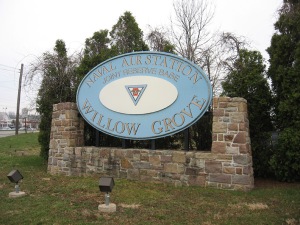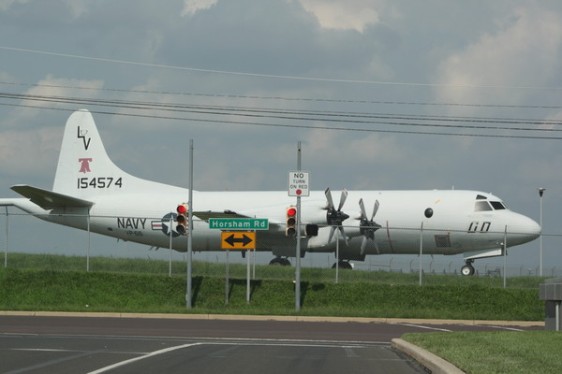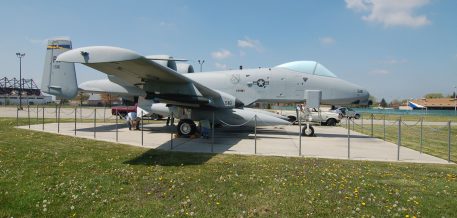(Dear Readers: This is a rather long-winded look at the Environmental Impact Statement (EIS) recently completed by the U.S. Navy on the BRAC-closed NAS-JRB Willow Grove base in Horsham, PA. I will not be offended if only the most local and interested Internet Wanderers have the strength and conviction to read it. – Mike)
 On January 13-14 the U.S Navy’s, Naval Facilities Engineering Command (NAVFAC), BRAC Program Management Office presented for public review, questions and comments it’s Environmental Impact Statement (EIS) related to the Horsham Local Redevelopment Authority’s (HLRA) redevelopment plan for NAS-JRB Willow Grove.
On January 13-14 the U.S Navy’s, Naval Facilities Engineering Command (NAVFAC), BRAC Program Management Office presented for public review, questions and comments it’s Environmental Impact Statement (EIS) related to the Horsham Local Redevelopment Authority’s (HLRA) redevelopment plan for NAS-JRB Willow Grove.
The turnout for the two-day event was light, as one would expect for such dry subject matter devoid of emotion-provoking arguments like those preceding the decision not to accommodate an airport at the base. But the 80-plus who did take the opportunity was a nice improvement over a public comment last year.
I picked Monday evening, January 13, to visit and submit those questions and comments I had regarding the evaluation the Navy was required to perform on the feasibility of the HLRA plan and the environmental impacts that could be reasonably projected from the plan.
EIS evaluations are not limited to impacts of redevelopment on the physical ecosystem. An EIS also looks at scope and costs of each Alternative Plan as well as each plan’s effects on Population; Housing; local Economy including Tax Revenue and Employment; School Enrollment; Transportation; Air Quality; Infrastructure and Utilities; Water Resources and Biologicals (wildlife).
Several basic issues should be kept in mind when reviewing the EIS. The EIS is mandated by the Base Realignment and Closure (BRAC) law, that sets the framework for transferring excess Government facilities and property to regional entities for reuse by the public. The EIS process requires that the evaluation address the broadest possible spread of Alternatives for redevelopment.
 This is why one alternative (Alternative 3) addresses the use of the closed base as an airport.
This is why one alternative (Alternative 3) addresses the use of the closed base as an airport.
This is not an indication, as I overheard one interested citizen conclude, that the federal government still prefers to turn the property into an airport! It’s simply the surprisingly efficient way the BRAC law requires all possible alternatives receive a thorough analysis in a single comprehensive treatment. This eliminates the possibility of another lengthy and costly EIS evaluation should the preferred plan require any changes, including increases or decreases in development density.
One shot, and it’s all treated equally, thoroughly, and cost-efficiently!
Now that being said, I will readily admit that until they start tearing that runway apart into miniscule pieces of industrial gravel or they build enough stuff on and around the runway to make any potential airport a foregone not-gonna-happen conclusion, I will consider that very remote possibility of an airport a possibility nonetheless.
By way of full disclosure, I work for Big G Government as a civilian employee of the U.S. Navy. I never had an issue – obviously – living within 1/4 mile of the airbase. But a private/commercial airport is another animal altogether. No thanks!
 If nothing else, besides its penchant for elaborate acronyms, the Navy’s EIS is extremely thorough in the depth and breadth of its environmental assessments. The EIS report runs over 450 pages long, not including the Appendix (770 pages) provided as a separate document on the BRAC PMO website.
If nothing else, besides its penchant for elaborate acronyms, the Navy’s EIS is extremely thorough in the depth and breadth of its environmental assessments. The EIS report runs over 450 pages long, not including the Appendix (770 pages) provided as a separate document on the BRAC PMO website.
The EIS begins with a well-written Executive Summary (ExecSum), which at just 26 pages, is as far as I got in my initial reading. My eyes tend to glaze over when confronted with an overabundance of detailed analysis, so I was content with reading the Summary knowing I could delve deeper into the minutiae if I wished on any specific area of interest.
Believe me, there was plenty of data to chew just on those livable 26 pages of summary presentation!
So that this post does not become overwhelming, I will concentrate on the comparative tables contained in the ExecSum. These tables are most useful in presenting the collective data in an easy-to-digest comparison between the four Alternatives addressed.
Of course, I will be addressing only those features of the EIS I find most interesting. My interests (density, economic impact, taxes) reflect those features I believe are most important to the long-term health of Horsham Township. Other challenges like traffic, water usage, hazardous material cleanup, etc. are also important within the larger context of economic feasibility.
The four Alternatives evaluated are as follows:
- Alternative 1: HLRA-approved/preferred plan consisting of 1486 Residential Units (RU), 2.3 million sq. ft. of industrial/retail space (non-residential); 240 acres of Open Space.
- Alternative 2: An even denser concentration of residential usage 1999 RU, 2.1 million sq. ft non-residential, 317 acres open space
- Alternative 3: The dreaded airport option … Take a deep breath and remember my discussion as to why this is included. Allows for 70 RU, 1.5 million sq. ft. non-residential, 299 acres open space
- Alternative 4: Doing nothing at all to the property. Obviously no development parameters, so there really is no treatment of Alternative 4’s impact. But the most obvious to keep in mind here are no tax revenue; but still the costs of site security, wildlife control, vegetation control, etc. remain and there would be no cut-through roads. One would assume this is no alternative at all, aside from serving as a baseline for the EIS comparisons.
Now my own personal opinion is that both Alternatives 1 & 2 contain higher density numbers than I would prefer to see. I have in the past shared my own whimsical ideas for the base property, and others have suggested their own to me. But that’s for another post at another time.
Here I will limit myself to comments on the EIS comparisons. The following Public Meeting Fact Sheet, made available at all the public EIS presentations, is most helpful when comparing the three primary Alternatives. It provides the potential impacts of all three alternatives in table format, making it easy to distinguish key elements.
Willow Grove Comparison of Alternatives
In addressing the HLRA-preferred Alternative 1, there is much to like … over 10,000 additional jobs, over $15 million in additional tax revenue, and 240 acres of new open space. But there are also concerns … an increase in population of 3500, another 570 children attending district schools along with increases in traffic, resource use, and demands on infrastructure and utilities.
I am skeptical of the estimated construction expenditures (one of my comments to the Navy on the EIS). These costs are estimated at $928 million to build out the entire Alternate 1 development plan. As someone unfamiliar with the real-life costing of major development projects, the figure seems too low to me. I find it difficult to believe the full build-out of this magnitude could be completed at level of investment.
That’s a problem for Developers however, not so much for Government or for Taxpayers. Assuming there is no public financing options provided to whomever qualifies to execute any build-out (other than tax incentives), the problem is one of developer financing and return-on-investment.
Alternative 2 with over 500 more residential units adds only an estimated $1.3 million in tax revenue because, although there are more residents, there are also fewer jobs (roughly 450-500 fewer). Not being a fan of Alternative 1’s level of residential density, it’s no surprise that I am not all that excited about Alternative 2’s even higher density level.
 Alternative 3 – of course – is a non-starter for me. However, the airport alternative would cost $274 million for build-out; includes 70 housing units for homeless veterans only. (This is included in all the alternatives.); 1.5 million square feet of non-residential space; but also generates only $4.2 million in annual tax revenue, most of which is coincidental to an airport operation. This revenue would come primarily from the planned hotel conference center and other non-residential development.
Alternative 3 – of course – is a non-starter for me. However, the airport alternative would cost $274 million for build-out; includes 70 housing units for homeless veterans only. (This is included in all the alternatives.); 1.5 million square feet of non-residential space; but also generates only $4.2 million in annual tax revenue, most of which is coincidental to an airport operation. This revenue would come primarily from the planned hotel conference center and other non-residential development.
The airport alternative still provides for 7500 jobs in the business park and hotel conference complex. Few jobs – one would surmise – would be directly related to airport operations, since airport proponents continuously tell us that this will be only a small private, limited commercial operation.
I do not buy that line of thinking. In my view, the only way an airport makes sense – both in self-sufficiency and local economic impact – is if much heavier commercial use exists there, be it commuter air services or freight operations. The pro-airport crowd will tell you otherwise however.
The last alternative – Alternative 4 – involves doing nothing, so there’s not much to address there. One piece of data from the HLRA consultant group is that it would cost the Township $20 million to take the property to pasture conditions (basically just grass and trees). This includes tearing up the runway and leveling the remaining buildings.
Obviously, not much of an option.
As anyone who pays attention to this process and the seemingly endless evaluation, recognizes that this process through the full build-out – in whatever form it takes in the end – will be a long tortuous road requiring a vision and insight into a future a lot of us might be too old to appreciate … me included.
None of the Alternatives nor their preferential rank means a twit without the development money and a perceived return-on-investment to the entity taking all the risk. To speak of town centers, golf courses, retail space or whatever at this juncture is simply a way of putting a very abstract vision into a form that can be valued and analyzed.
What the EIS helps to illustrate – in an indirect way – is the complexity of the picture, the range of permutations possible, and if one listens closely, the importance of taking our time in carefully putting the puzzle together. This leads me to laugh at stories on local media sites where people complain about a lack of progress in the base’s abandoned state. Articles bemoaning a lack of progress in activity on redevelopment forgetting rather conveniently that Governor Rendell caused a few years worth of delay by pursuing a well-intentioned solution to keep the runway as a regional asset if a solution could be found to make it economically self-supporting.
When it comes time to stick shovels into earth, those with the deep financial pockets will certainly want a say in what is developed on the NAS-JRB property with their money. Any interested developer will – no doubt – have a significant say in that decision-making process.
A healthy vision – represented by the preferred HLRA alternative – serves as a starting point from which those inevitable revisions can be properly evaluated. Regardless of what the final product looks like, such a structured approach is intended to ensure the best possible decisions are made for the future of Horsham Township and the surrounding community.



Mike,
In a lot of ways, I agree with your assessment of the EIS. I’ll say right off the bat that I believe the base should remain an airport. And it should not be limited to general aviation. Corporate aviation and light cargo operations, aircraft manufacturing, support, and related technical industry should be encouraged, rather than discouraged.
True, much infrastructure would have to be repaired, built, or brought up to code, but the costs for the airport option, outlined in the EIS, are only about 1/4th of Horsham’s desired alternatives.
If you remember, the Navy worked with surrounding townships and closed the airport to flight operations for around 8 hours each night, and flight paths into and out of the base were designed to minimize noise impact and maximize safety for all. Is there any reason to think that similar arrangements could not be made in civil use?
The EIS stated pretty specifically that aviation related noise levels measured in 2010 beyond the airfield perimeter were not even close to hazardous to anyone’s hearing. In fact, only if one was near the southeast corner (Think intersection of Maple Ave. and 611) during flight operations, would it be difficult to hold a conversation. The EIS didn’t address noise from aircraft flying overhead, but the EIS did say that noise levels if the base became a civilian airport would be less than measured in 2010.
Regards traffic on the roads, if anyone thinks the traffic in and around Horsham is too much now, look at the EIS and see what is forecast under any of the alternatives, but especially if Alternative #2 is chosen. But, like you said, money talks, and it’ll take a lot of it to make any of the first three alternatives work.
Fortunately, or unfortunately, I live in Warminster. But if I were a Horsham resident, I’d be concerned about JUST how much of a tax burden it would be to provide and maintain all the increased municipal services that would be required under Alternatives 1 & 2. Look at what the EIS says about waste water management under alternative #2. That’s an eye opener.
Alternative #2 also pretty much mandates a new middle school would HAVE to be built to accommodate the increase number of students. So, not only are we talking about significant increases in demand upon infrastructure that isn’t even built yet, but there’ll be a need for more fire, police, school teachers, and township employees to service the growth. Think about wages and pensions for all those new employees. There are crises all over the state already with under funded pension plans.
Will increases in property tax and local income tax revenue be enough to offset all that growth? Who can say? How many Horsham taxpayers are that optimistic? So, I guess we’ll see what the future brings.
Personally, I’m glad I don’t live in Horsham, and I’m not too thrilled about living in this area as it is. I moved here almost 33 years ago, when we had the Bucks County drive in, and not much else between the base and Bristol Road to the north but farms and woods, and you could drive from 611 down Street Road pretty much all the way to the old Naval Air Development Center seeing open space, woods, farms, and a lot less residential development than you see now. I don’t like the congestion that has come our way, and I don’t see Horsham’s preferred Alternatives doing anything but increasing it. My two cents.
BTW, I am US Navy retired, I spent 12 of my active duty years stationed at NAS Willow Grove, I gave a big chunk of my life in support of the air museum on the base, and I have spent the majority of the past 19 years since I retired from active duty as a DOD contractor. My two cents, but I hope some folks will see the coming decisions from the Department of the Navy in a clearer light, and not necessarily agree with me, but perhaps a little more aware of what the future may bring.
LikeLike
John:
I’m having deja vu’, ’cause I’m pretty sure we have had this conversation before. I was just looking at some old posts on “Reuse the Base” today. Small world …
You know my position. I keep going back to my core fear of an airport. They never stay the same. They get bigger, busier, louder; not the other way around.
So in what regard do all those EIS analysis tell us about what living in very close proximity to such an airport in 10 or 20 years? Not much … Because they speak only of a limited-use muni airport.
Even when it comes to operating hours and flight paths – as you mentioned – nothing could be guaranteed to go unchanged if flights increase and business makes money. No guarantees or even “promises” would be made when it came to how an airport would operate into the future.
My expectation is that tax revenues will exceed the costs of needed infrastructure, public services, etc. if managed intelligently. One thing I can trust Horsham to do, given history in the township.
I’m no fan of the density of the HLRA preferred alternative. But again, much of that is going to be decided by the market. How congestion is addressed is another matter altogether. I can’t imagine 611 remaining what it is today if a dense residential layout ends up there.
That still doesn’t push me off my position though.
Thanks, John for your comments and your Navy service! Always glad to have a spirited and respectful conversation. It is an emotional issue.
– Mike
LikeLike